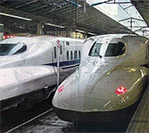SHINKASEN GLORY: Success most often occurs in the presence of problems and limitations, not the absence of it
THIS October marks the 50th anniversary of Japan’s iconic Tokaido Shinkansen, or New Trunk Line. Launched on Oct 1, 1964, nine days before the start of the Tokyo Olympics, Hikari No. 1 left Tokyo station on a scheduled journey that would eventually carry 5.5 billion passengers over the next five decades.
Today, 13 dangan ressha (bullet trains) run from Tokyo to Osaka hourly in each direction or one every five minutes. Although they run at speeds of up to 320kph, they have an unblemished safety record. There has never ever been a fatality from an accident or derailment, apart from the occasional suicide.
Equally mind-blowing is the fact that delays per train averaged just 50 seconds last year. The year before that it was 36 seconds. As a feat of engineering and railway operation, the Shinkansen has no equal. Unlike slogans elsewhere, its motto of speed, safety and stability is no mere hollow promise.
It represents what one has come to expect from the Japanese: superb engineering, unparalleled safety and precision operations.
What Malaysians do not realise, however, is that when the bullet train was conceived back in the 1930s, Japan was a far cry from what it is today.
Official statistics from this period are not highly reliable but economic historians place Japan’s standard of living at only 30 per cent of the US’ in 1930. It was a country that, quite frankly, was a political, economic and foreign policy mess, run by a fascist government that would enter World War 2 in 1940.
In 1940, the Japanese Diet funded the bullet train project but later aborted it due to other war priorities. When the government surrendered to the Allied forces in 1945, after two atomic bombs were dropped on two of its’ most important cities, Japan’s gross domestic product per capita had halved.
Its post-war economic reconstruction is now legendary but when work resumed on the Shinkansen in April 1959, Japan had only recently surpassed pre-war levels.
Scarcity was still very much in evidence everywhere as the country shouldered the burden of war reparations.
Lesser countries would have buckled. By pursuing a fully electrified high-speed rail, Japan was attempting a technological feat that no country had accomplished.
The plan was deemed impractical due to the narrow track gauge that had been laid throughout the mountainous and earthquake-prone country.
Led by a visionary and tenacious president called out of retirement, Shinji Sogo, the project faced financial difficulties, political resistance, engineering problems and, of course, public disapproval.
Yet, under Sogo’s leadership, Japan National Railways (JNR) constructed an entirely new railway network in just over five years.
Did Japan have the human, financial, organisational and technological wherewithal to build and operate the bullet trains? Did it have widespread approval of politicians and the public? Did it hire highly-paid professional consultants and parcel out work to foreign engineering firms and workers via sweetheart deals?
The answer to each of these questions is an emphatic “no”. The project faced what almost every project of scale and significance faces.
An economist doing a cost-benefit analysis then would have come to the conclusion that the costs would outweigh the benefits. Engineers would have come to the same conclusion.
JNR did not have all the answers to the problems of the day in hand. Through dogged dedication, however, solutions were found. Workers paid scant regard to personal inconveniences or glory.
Sogo and his chief engineer were forced to resign before the project was finished to take responsibility for cost overruns.
And still they achieved not just a monument to railway engineering but humans and organisation. The standard performance set have benefited millions of Japanese and quite a few non-Japanese as well over the past five decades.
When we look at what preoccupies the minds of Malaysians today, it is hard to envisage a Shinkansen type project happening any time soon. Caught in petty arguments of words over works and forms over substance, all sides seem determined to tear up the social fabric rather than strengthen it.
Success most often ‘occurs in the presence of problems and limitations, not the absence of it. The secret is not better policies (although these do help) but in the social cohesion that enables duty and sacrifice to a higher purpose to prevail. Japan found it in the Shinkansen and post-war recovery in general. Malaysians are still flailing, dreaming big dreams but unwilling to pay anything forward and to go the distance.
Article by Dato’ Steven Wong which appeared in New Straits Times,
7 October 2014.





